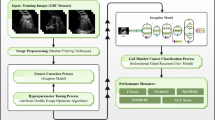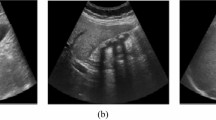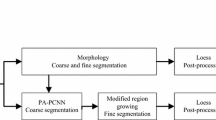Abstract
Gallbladder cancer is a relatively rare but highly malignant tumor. This study mainly explores the CT findings of gallbladder cancer based on neural networks. This study designed a gallbladder cancer LDCT image denoising network. Ability to process different doses of gallbladder cancer LDCT images with significant differences in noise and artifact distribution, this study designed the noise level estimation sub-network as a codec structure; the decoding part is used to generate the noise level of the gallbladder cancer LDCT image Artifact image. Artificial neural network is a kind of artificial neural network that simulates the behavior characteristics of animal neural network and achieves the purpose of processing information by adjusting the interconnection between a large number of internal nodes. In order to meet the requirements of medical diagnosis for gallbladder cancer LDCT image quality, this study designed the backbone noise reduction network as a GAN framework that can be internally optimized. The discriminator network structure of this study is a multi-scale inception structure. As a sub-network of GAN, the discriminator network is used to distinguish true and false images and constrain the generator to make the generated images close to real images. In addition, it can be used as a noise evaluation sub-network to evaluate the noise gallbladder cancer LDCT. The treatment methods of gallbladder cancer include surgery, chemotherapy, radiation therapy, arterial interventional perfusion therapy, targeted therapy, etc. Surgery is currently the first choice for the treatment of gallbladder cancer, and the choice of surgery depends on the stage and growth site of gallbladder cancer. The image denoising network was used to evaluate the quality of the noise-reduced image. The average precision of GAN network for gallbladder cancer area is 91.0%, and the highest value is 95.2%. This study will provide a reliable reference value for the auxiliary diagnosis of gallbladder cancer.





Similar content being viewed by others
Explore related subjects
Discover the latest articles, news and stories from top researchers in related subjects.References
Lu H, Setiono R, Liu H (2016) Effective data mining using neural networks. Knowl Data Eng IEEE Trans 8(6):957–961
Ko CH, Chen JK (2017) Grasping force based manipulation for multifingered hand-arm robot using neural networks. Numer Algebra Control Optim 4(1):59–74
Goh ATC (2017) Seismic liquefaction potential assessed by neural networks. Environ Earth Sci 76(9):1467–1480
Pereira S, Pinto A, Alves V et al (2016) Brain tumor segmentation using convolutional neural networks in MRI images. IEEE Trans Med Imaging 35(5):1240–1251
Gong M, Zhao J, Liu J et al (2017) Change detection in synthetic aperture radar images based on deep neural networks. IEEE Trans Neural Netw Learn Syst 27(1):125–138
He H, Gang F, Jinde C (2019) Robust state estimation for uncertain neural networks with time-varying delay. J Jishou Univ (Nat Sci Ed) 19(8):1329–1339
Roth HR, Le L, Liu J et al (2016) Improving computer-aided detection using convolutional neural networks and random view aggregation. IEEE Trans Med Imaging 35(5):1170–1181
Guenther F, Fritsch S (2016) neuralnet: training of neural networks. R J 2(1):421–430.
Valipour M (2016) Optimization of neural networks for precipitation analysis in a humid region to detect drought and wet year alarms. Meteorol Appl 23(1):91–100
Ganin Y, Ustinova E, Ajakan H et al (2017) Domain-adversarial training of neural networks. J Mach Learn Res 17(1):2096
Carleo G, Troyer M (2016) Solving the quantum many-body problem with artificial neural networks. Science 355(6325):602–606
Kiranyaz S, Ince T, Gabbouj M (2016) Real-time patient-specific ECG classification by 1-D convolutional neural networks. IEEE Trans Biomed Eng 63(3):664–675
Alanis AY (2018) Electricity prices forecasting using artificial neural networks. IEEE Latin America Trans 16(1):105–111
Wang P, Li W, Gao Z et al (2016) Action recognition from depth maps using deep convolutional neural networks. IEEE Trans Human Mach Syst 46(4):498–509
Zhao H, Nan D (2017) Dynamic analysis of stochastic Cohen-Grossberg neural networks with time delays. Appl Math Comput 183(1):464–470
Fang T, Sun J (2017) Stability of complex-valued recurrent neural networks with time-delays. IEEE Trans Neural Netw Learn Syst 25(9):1709–1713
Tajbakhsh N, Shin JY, Gurudu SR et al (2016) Convolutional neural networks for medical image analysis: full training or fine tuning? IEEE Trans Med Imaging 35(5):1299–1312
Gong C, Zhou P, Han J (2016) Learning rotation-invariant convolutional neural networks for object detection in VHR optical remote sensing images. IEEE Trans Geosci Remote Sens 54(12):7405–7415
Chen CLP, Wen G, Liu Y et al (2017) Adaptive consensus control for a class of nonlinear multiagent time-delay systems using neural networks. IEEE Trans Neural Netw Learn Syst 25(6):1217–1226
Maggiori E, Tarabalka Y, Charpiat G et al (2016) Convolutional neural networks for large-scale remote sensing image classification. IEEE Trans Geosci Remote Sens 55(2):645–657
Author information
Authors and Affiliations
Corresponding author
Ethics declarations
Conflict of interest
The authors declare that they have no conflict of interest.
Additional information
Publisher's Note
Springer Nature remains neutral with regard to jurisdictional claims in published maps and institutional affiliations.
Rights and permissions
About this article
Cite this article
Chang, Y., Wu, Q., Chi, L. et al. CT manifestations of gallbladder carcinoma based on neural network. Neural Comput & Applic 35, 2039–2044 (2023). https://doi.org/10.1007/s00521-022-06973-4
Received:
Accepted:
Published:
Issue Date:
DOI: https://doi.org/10.1007/s00521-022-06973-4




